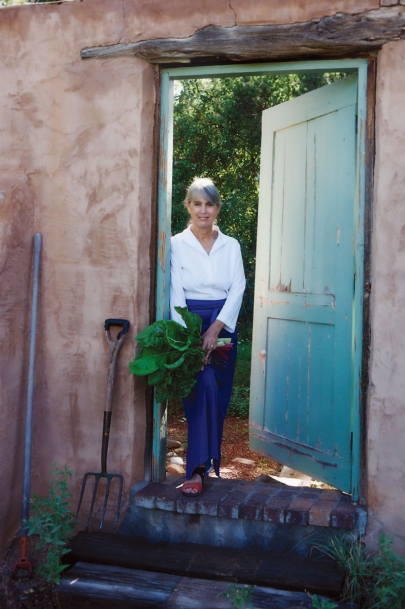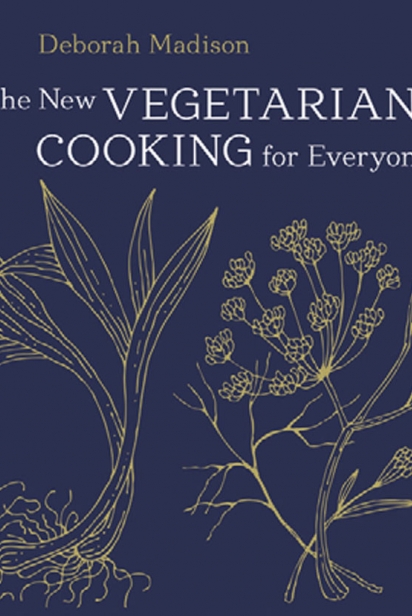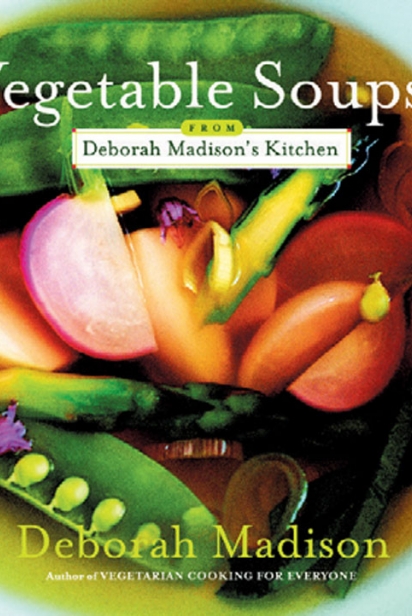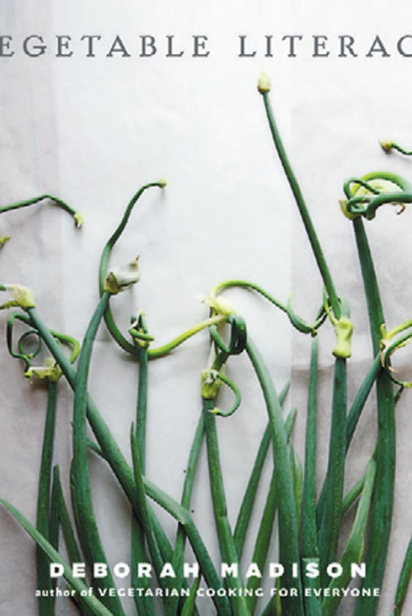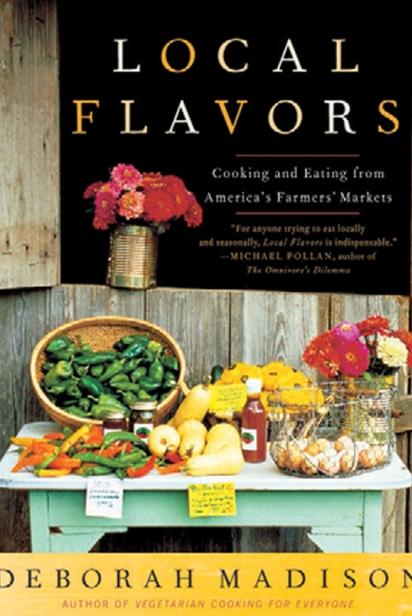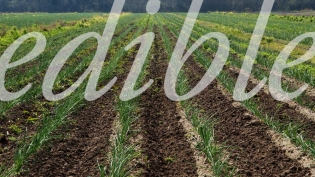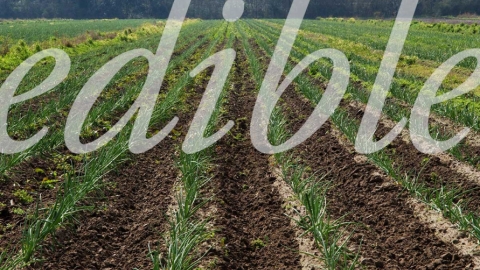Deborah Madison, Food Culture Maverick Without Compromise
Unless you crave ceremony, Deborah Madison needs little introduction. Her ubiquitous cookbooks (14 published), so divine yet unceremonious, have tilled new soil in the food world. A James Beard Awardee, she persevered before trendy food authors, the Food Network, corporations and hip food tech start-ups colonized the idea of “locally sourced” or “sustainable” food.
Food in Deborah’s hands is so much more than that—it is a mouthwatering mandate for a life worth living.
When I met Deborah in Santa Fe, New Mexico, our spouses had an art exhibition together at the Dwight Hackett Projects. I had the rare privilege of eating two meals cooked by Deborah. The first was at her home, where she served a rustic and simple South Asian chicken dish. I will never forget it. It arrived at the table—ripe ingredients, intimate with the use of spices and cooked with intention.
The next feast was at Dwight Hackett Projects on St. Patrick’s Day. After the show’s opening, Deborah transformed bustling art-opening minglers into attentive Irish-food lovers. She cooked a corned beef and cabbage extravaganza. We sat at a long table with about 20 people. Deborah served the food herself. The gallery dealer poured the wine.
Aside from the unforgettable food, Deborah was so understated and gracious that, if one did not know her accomplishments, one might be shocked just how illustrious her career has been.
EB: I want to begin with an echo of “permaculture.” It encompasses so much of your work. You seem to begin your process with observation. How does permaculture influence your current thinking about rearing vegetables?
DM: Whenever I encounter permaculture, whether through a class, a garden visit or a book, I find it makes amazing sense. Always. It seems complicated at first, but in the end it’s so practical. And that’s what’s exciting about it. Do I practice it in my garden? Maybe to the extent that after growing all kinds of vegetables for Vegetable Literacy (Ten Speed Press, 2013) that weren’t necessarily at home here in the Southwest, I looked around and asked myself what likes to grow, really likes it here, wants to thrive? And decided to focus on those plants. Oddly enough, although they are domestic cultivars (chard, orach, beets, etc.) there are a number of wild members of the same family group that thrive around Santa Fe, like four-wing saltbush. Not a leafy green by any means, but it thrives. I’m not sure if this is part of permaculture, but I try to use the shade provided by some plants to foster smaller shade-loving vegetables, like lettuce growing beneath mature carrots, something I learned from Alan Chadwick in his garden at UC Santa Cruz. I’m still getting to know my garden and its possibilities. Feeling my way.
In a 2013 interview in the blog Weird Vegetables, you stress varietals and vegetable families. Most of us don’t notice the genetic relationship between varietals because they seem so different. You explore such connections by cutting open a Belgian endive root, observing a bitter sticky sap. And then you remind us of this connection to lettuce (which also yields a white, bitter sap and whose leaves become bitter as they mature). A book cannot teach this. It is about being sensually attentive. What is the importance of varietals for contemporary planting, farmers’ markets, health and eating?
I started noticing similarities among members of the umbellifer family when I let my carrots flower in their second year. Their lacy caps (so attractive to bees and wasps!) were not dissimilar to the flowers of other members of the family that I had in my garden—parsley, lovage, cilantro, cumin, fennel, dill, chervil—and that got me thinking about families, what they are, who’s in them and what similarities they share. The more I looked, the more I saw and the more excited I became. Vegetable Literacy was the immediate result—a rather elementary look at those botanical families whose members we most often eat.
In the end I concluded you don’t really have to know any of this to get dinner on the table, but if you do get a glimpse of relationships, a world is opened up to you. For example, spinach, chard and beets are all related and the leaves taste rather similar so you can use them more or less interchangeably. In addition, other members include wild spinach, quinoa, orach and amaranth, which are also similar in taste and behavior, so if you know that, maybe you’ll be inclined to extend your reach to eat leaves you’ve never tried before. These greens are very different from those in the mustard, or cruciferous family—broccoli, kale, cauliflower, collards to name just a few. But those are not so dissimilar to one another. If you garden, you might be curious to give your broccoli and cauliflower greens a try.
Some farmers—one in our market, for example—have already drawn a connection, and now we can buy broccoli leaves that would normally be left in the field. You’ll want the smaller ones, most likely. Now marketers have caught on to this and they’re selling broccoli leaves, but in my experience they’re too big and old. Small, tender and fresh (and therefore local) leaves are good to eat. There’s also a company selling “Heirloom Red Spinach” at Trader Joe’s, which is orach. It’s always wilted and unappealing in the bag, but great in the garden, and easy to grow.
How have you cultivated consciousness about plant life?
I don’t really know, exactly. Maybe it’s that plants speak to me. I notice them. I stop to look at them, bend down to touch them, smell them. I like plants. And I love to look at them as family members because they’re like human families—you see similarities that make you think “Aha! Sorrel must be related to buckwheat, and what about that rhubarb in flower? That, too. Yes!” Of course, I’m wrong sometimes, maybe even a lot of the time, but just looking at plants provokes curiosity.
Can you talk about the movement in raised bed gardening and why it is so important? Is it about the drought, city gardens, better soil or pest control?
Perhaps it depends where you live. I live in the Southwest. Our soil is mostly heavy clay and it’s very hard to work. It can feed plants, but it takes years of adding organic matter to make it friable and pleasurable to work. After working at this for many years I finally asked a friend to make me a bed, and he not only did that, he made a business of making raised beds and summer and winter covers. What’s good about these beds is that they work! You fill them with something that’s more like soil than adobe. (And if you should happen to have ground that is toxic from former use, that’s something to consider.) The covers protect plants from cold in the winter, extra heat in the summer. You can drip them so you’re using less water than you might otherwise. If you’re a parent who wants to see your kids become excited about growing something to eat, you can have results right away, while they’re young, before they’re young adults. Also, if you don’t have much room, there’s a lot you can grow in a raised bed, whether it’s small enough to wheel around a patio (this does exist!), a 4- by 4-foot bed, or even larger.
Does this relate to narrowing the scope by eating seasonally?
It could, if you’re really relying on beds for your food. Some, but not all, gardeners with raised beds are. They grow a few things then go elsewhere for the rest. Or, they grow only in the summer, but we eat year around. I hand it over to the professionals for a lot of my foods—that is the farmers who sell at the farmers’ market—and grow what works well for me, mostly members of the amaranth family: chard, spinach, amaranth, beets, etc.
In our epidemic of hunger in the U.S., how would you recommend we eat vegetables?
Since vegetables depend on water, a vanishing substance, I think it’s good to view vegetables as valuable, both as a product of water and soil and because of what they offer us. Calling them “vegetables,” not “veggies,” would be a good start. “Veggies” is such a belittling word and vegetables are powerful, as we should all know by now.
One thing I’ve learned as a gardener is that you are much more tolerant to flaws in your vegetables, be they tomatoes partially chomped on, a squash or a bean that got too big for your (prior?) standards. You just cut away the bad parts; you cook the big beans longer than little ones and they’re fine. Same with vegetables marred by hail or munched on by grasshoppers. They’re still food for us. We need to get over the idea of “perfection” that the supermarket aims for, even though something that’s truly well grown by an expert gardener or farmer is in fact gorgeous and perfect. Most people don’t realize that a lot of food is not considered acceptable by the supermarket, such as a too-large avocado or peppers with a lot of curves. If it’s in your garden, it’s amazingly acceptable.
Lastly, we might eat more of the plant, not just the cauliflower crowns but the cores and smaller leaves; the chard stems as well as the leaves. There are lots of examples of eating the whole plant, especially from other cultures, that I touched on in Vegetable Literacy. I think [the fact that] we’re so used to seeing and using just part of the plant is a contributor to food waste!
How do we know vegetables are truly organically raised?
It’s not so easy, really. I like to hope that USDA certification means something—at least no GMOs, but I’m not always confident that it does.
Right now there’s an issue about certain California so-called organic companies that use wastewater from fracking for irrigation, water that is known to be contaminated with toxic chemicals and oil. This is permitted? Apparently. Do you really want to be consuming toxic chemicals via a little tangerine? I don’t! There’s also the matter of aluminum particle fallout from geo-engineering (aka chemical trails). Where does it go? In our water? The ground? On crops?
It’s very discouraging today to imagine we’re getting truly organic foods. But even so, I know my farmers and have for many years, and I think that’s most important. I trust them, whether certified organic or not. I’ve been to their farms. I’m also familiar with other certification groups that I respect, such as CCOF, so I look for their stamp as well. I talk with farmers, go to agriculture conferences and basically try to inform myself about growing methods of farmers. It’s more effort than reading a label, for sure, but more interesting too. And I know I’m not putting weird stuff into the soil or onto the plants that I grow to eat. But what am I truly eating? Is it really organic? I think it’s hard to know, outside of farmers and their good practices.
Why is it important to write food articles that engage politics?
I think we have enough recipes—at least from me. I love all the diversity of plant foods we’re seeing today, but it’s not enough just to make a pretty plate. Do we know what we’re eating, really? How it was raised? How much a laborer got paid for doing the tough job of bringing in your line-caught tuna or harvesting pesticide-laden artichokes or even your organic ones? What’s it really like to be a young farmer with a spouse and children trying to get started? What do young people need to continue agriculture today? And there’s no doubt that we do need young farmers. And, of course, how do changing climate patterns impact farming and what we eat?
I’ve always been interested in how food comes to us and how knowing that that might change our relationship to it by giving it more value, or less. The stories I’m interested in may not be political in themselves, such as what goes into making grass-fed beef in the arid West and why it’s a great benefit to the land and wildlife. They’re more about helping us to be better informed about what’s easy to misunderstand. And of course there could be political ramifications down the line.
What are you reading currently?
What I’m reading is always changing. I just finished Living to Tell The Tale, Gabriel Garcia Marquez’s long book about his life up to the point of meeting his wife. Joan Didion’s Where I Was From, for the second time. To a Californian, which I am even though I’ve lived in New Mexico 25 years, California is a compelling subject, one I work to understand. Beasts of The Field by Richard Street is another (huge) book on California agricultural history starting with the Jesuits in Mexico—a very sobering and important book, which I’ve been reading at for months. Since I’m working on a memoir, I’m reading other people’s memoirs (Nabakov, Mary Karr, etc.) and The Situation and the Story by Vivian Gornick, and Dani Shapiro’s wonderful book Still Writing. And I’m reading a book on seeds.


